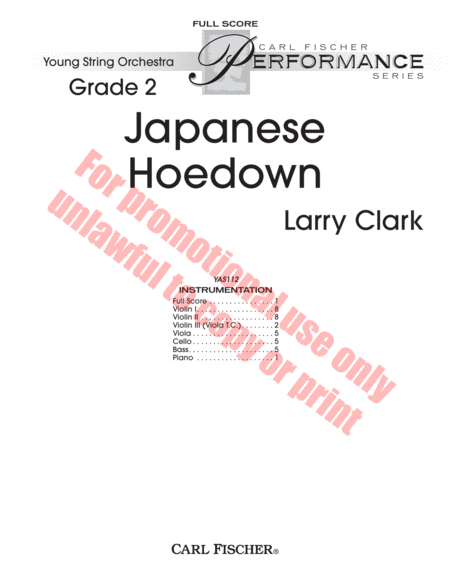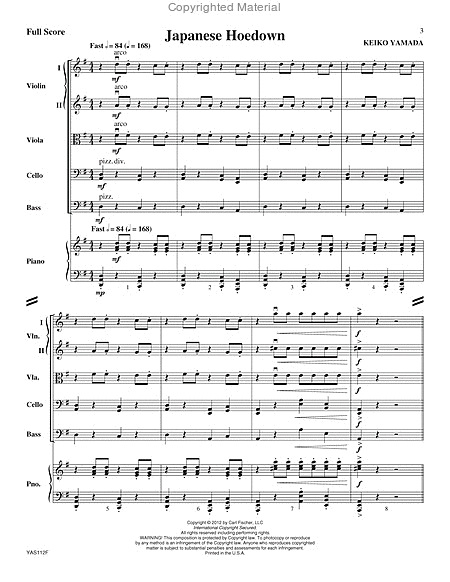Japanese Hoedown
Details
Description
SKU: CF.YAS112
Composed by Larry Clark. SWS FS. Young String Orchestra. I thought it might be fun to see what it would be like if I wrote a piece with two diverse styles together. So, I ventured to write a piece that combines the American hoedown sensibilities with a Japanese flavored pentatonic melody. This piece is the resu. Score and part(s). With Standard notation. Carl Fischer Music #YAS112. Published by Carl Fischer Music (CF.YAS112).ISBN 9780825889356. 798408089351. 8.5 x 11 inches. Key: G major.
Larry Clark combines elements of Japanese folk music with the music of the American hoedown, and the result is a party! The main tune is pentatonic, but the background parts are pure hoedown. Japanese Hoedown sounds cool and different, but familiar at the same time. There is even an open section for improvisation that can be played using a D pentatonic scale, and an example solo is provided as well.
I thought it might be fun to see what it would be like if I wrote a piece with two diverse styles together. So, I ventured to write a piece that combines the American hoedown sensibilities with a Japanese flavored pentatonic melody. This piece is the result. The work begins with fiddle-style accompaniment figures as the introduction. Notice the way the two eighth notes are marked with the second note of the two short, typical of this style. The main pentatonic tune follows with a pizzicato bass line, then repeats, but with more Japanese style pizzicato figures. The second theme is a bit more hoedown-like in structure and harmony and is presented in the celli with a return of the fiddle-style eighth notes. The main theme returns again, this time harmonized and with more plucking in the lower strings. After a return of the intro material and a long ritardando (which should slow down a lot) there is a fun opening for a solos section. An example solo is provided that can be used, or you can open this section up and repeat as many times as you want to give students the opportunity to try improvising. Its simple in the fact that a good solo can be played using only the five notes of the D pentatonic scale. Once you decide to move on from solos, the second theme returns which leads into the finale through the main theme. An accelerando propels the work to the coda using fragments of the melody and of the example solo as the material for a dramatic hoedown-style ending. I hope this piece will be fun.
About Carl Fischer Young String Orchestra Series
This series of Grade 2/Grade 2.5 pieces is designed for second and third year ensembles. The pieces in this series are characterized by:
--Occasionally extending to third position
--Keys carefully considered for appropriate difficulty
--Addition of separate 2nd violin and viola parts
--Viola T.C. part included
--Increase in independence of parts over beginning levels


 Share
Share